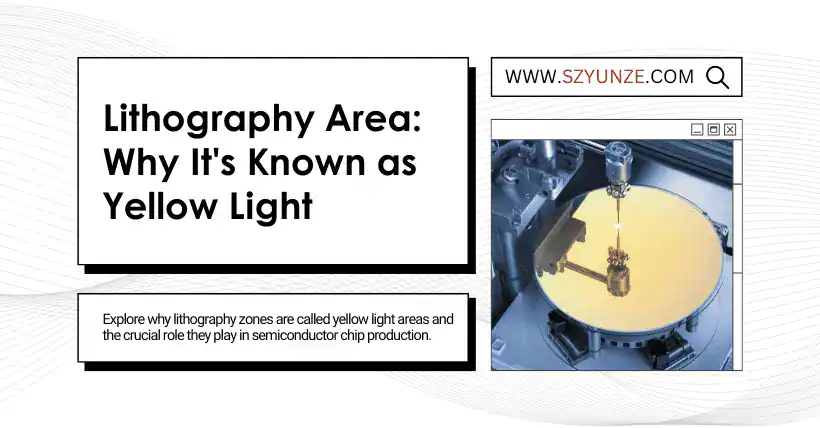Entering the photolithography area of a semiconductor cleanroom, the yellowish lighting always leaves a lasting impression. This seemingly ordinary yellow glow is, in fact, a precisely engineered design that integrates photochemical principles, material properties, and human ergonomics in semiconductor manufacturing. The practice of randomly installing yellow light tubes in newly built labs to cut costs overlooks the complex technical constraints behind this lighting choice.
01
Photosensitivity of Photoresist: Wavelength Sensitivity Threshold
Photoresist, the core material in photolithography, typically contains photosensitive compounds, resins, and solvents. The key to its photosensitive behavior lies in its threshold for light wavelengths. Research shows that photoresist is effectively sensitive to wavelengths in the 200–500 nm range, which includes ultraviolet (10–400 nm), violet (400–450 nm), and blue light (450–495 nm). These short wavelengths trigger photochemical reactions in the photoresist, causing molecular structure changes—this is both the foundation for pattern transfer in photolithography and a “potential threat” that must be strictly avoided during non-exposure steps.
02
Wavelength Filtering by Yellow Light: Creating an Optical Safety Barrier
The spectral range of yellow lighting is approximately 570–620 nm, a choice based on several technical considerations:
- Photochemical Safety: Wavelengths above 570 nm are well beyond the photosensitivity threshold of photoresist (below 400 nm), creating an “optical safety zone.” During non-exposure processes such as photoresist coating and mask alignment, yellow lights provide the necessary illumination without risking unintended photoresist exposure. Importantly, compliant yellow lights are specially filtered to ensure no dangerous 200–500 nm wavelengths are emitted.
- Visual Ergonomics Optimization: Yellow light falls within a region where human vision is highly sensitive (with peak sensitivity at 555 nm for green light). Compared to red (620–750 nm) or green light (495–570 nm), yellow light offers better visibility. Studies show red light reduces detail recognition, and green light can cause glare on smooth surfaces like wafers. Yellow light strikes a balance between visual clarity and comfort.
03
Multidimensional Constraints in Lighting Selection: Beyond Single Technical Aspects
Lighting design in photolithography areas must satisfy multiple requirements:
- Minimizing Optical Interference: The gentle spectrum of yellow light reduces glare from reflections on equipment and wafer surfaces, avoiding visual distractions for operators—critical for nanoscale alignment operations.
- Color Recognition Accuracy: In processes involving color-sensitive materials (like certain developers or test reagents), yellow lighting minimizes color distortion, ensuring accurate assessment of material states by operators.
- Ergonomic Considerations: Photolithography in semiconductor fabrication often involves several hours of continuous work. The spectral properties of yellow light help reduce eye fatigue, making it more suitable for long-term operation compared to blue or white light.
04
From Yellow to Orange: Practical Application of the Spectrum
It’s important to clarify that the “yellow light” in photolithography areas is not a single wavelength, but spans a wide spectrum from 570–620 nm. This means actual lighting may range from deep yellow to light orange in tone. Spectral analysis in an advanced photolithography room revealed a main peak at 590 nm with some orange light components around 610 nm—this blended spectrum satisfies the core requirement of “non-photosensitive wavelengths” while enhancing visual comfort through color temperature adjustments.
In semiconductor manufacturing, even a seemingly simple lighting choice embodies interdisciplinary intelligence spanning material science to engineering psychology. Ignoring professional design and arbitrarily selecting yellow lights may result in insufficient spectral purity or improper color temperature, leading to unintended photoresist exposure or operational errors that ultimately affect chip yield. This detail underscores a fundamental truth about the semiconductor industry: in nanoscale manufacturing, every technical decision requires thorough validation from principle to engineering execution.
Related:

Disclaimer:
- This channel does not make any representations or warranties regarding the availability, accuracy, timeliness, effectiveness, or completeness of any information posted. It hereby disclaims any liability or consequences arising from the use of the information.
- This channel is non-commercial and non-profit. The re-posted content does not signify endorsement of its views or responsibility for its authenticity. It does not intend to constitute any other guidance. This channel is not liable for any inaccuracies or errors in the re-posted or published information, directly or indirectly.
- Some data, materials, text, images, etc., used in this channel are sourced from the internet, and all reposts are duly credited to their sources. If you discover any work that infringes on your intellectual property rights or personal legal interests, please contact us, and we will promptly modify or remove it.



